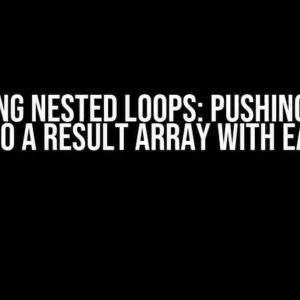Are you tired of banging your head against the wall, trying to solve a problem that seems impossible? Do you want to prove that a certain problem is unsolvable within a specific time complexity? Look no further! In this comprehensive guide, we’ll take you through the steps to prove that a problem is unsolvable in a certain time complexity. Buckle up, and let’s dive in!
Understanding Time Complexity
Before we dive into the meat of the article, it’s essential to understand what time complexity is. Time complexity refers to the amount of time an algorithm takes to complete, measured by the number of operations performed. It’s usually expressed as a function of the size of the input, typically represented as ‘n’. For example, an algorithm with a time complexity of O(n^2) takes quadratic time, while an algorithm with a time complexity of O(log n) takes logarithmic time.
Why Prove a Problem is Unsolvable?
Proving that a problem is unsolvable within a certain time complexity is crucial for several reasons:
- Resource Optimization**: By knowing that a problem is unsolvable within a certain time complexity, you can allocate resources more efficiently. You can focus on developing alternative solutions or optimizing existing ones.
- Theoretical Foundations**: Proving that a problem is unsolvable helps establish the theoretical foundations of computer science. It provides a deeper understanding of the fundamental limits of computation.
- Real-World Impact**: In some cases, proving that a problem is unsolvable can have significant real-world implications. For instance, in cryptography, proving that a certain problem is unsolvable can ensure the security of encryption algorithms.
Step 1: Understand the Problem Statement
Read the problem statement carefully. Make sure you understand what the problem is asking and what the constraints are. Pay attention to the input size, the desired output, and any specific requirements or assumptions.
Example Problem Statement
Solve the following problem:
Given an array of integers, find the maximum sum of a contiguous subarray within a time complexity of O(n).
What’s the problem asking?**: Find the maximum sum of a contiguous subarray.
What’s the constraint?**: The time complexity must be O(n).
Step 2: Determine the Lower Bound
Determine the lower bound of the problem. This is the minimum time complexity required to solve the problem. To do this, you can use various techniques, such as:
- Divide and Conquer**: Break down the problem into smaller sub-problems and solve each recursively. This helps establish a lower bound on the time complexity.
- Information-Theoretic Arguments**: Use information-theoretic arguments to demonstrate that a certain amount of information must be processed, thereby establishing a lower bound on the time complexity.
In our example problem, we can use the divide-and-conquer approach to establish a lower bound of Ω(n). This is because we need to process each element in the array at least once to find the maximum sum.
Step 3: Analyze the Algorithm
Analyze the given algorithm or propose a new one. Study the algorithm’s time complexity and try to optimize it. If you’re proposing a new algorithm, design it with the goal of achieving the desired time complexity.
In our example problem, let’s propose a simple algorithm:
Algorithm: Brute Force Algorithm 1. Initialize max_sum = -∞ 2. For each contiguous subarray: 1. Calculate the sum of the subarray 2. If the sum is greater than max_sum, update max_sum 3. Return max_sum
This algorithm has a time complexity of O(n^2), which is far from the desired O(n) time complexity.
Step 4: Prove the Problem is Unsolvable
Prove that the problem is unsolvable within the desired time complexity. Use the lower bound established in Step 2 and the analysis of the algorithm in Step 3 to demonstrate that the problem cannot be solved within the desired time complexity.
In our example problem, we can prove that the problem is unsolvable within O(n) time complexity using the following argument:
Since the lower bound is Ω(n) and the best known algorithm has a time complexity of O(n^2), it's impossible to achieve a time complexity of O(n) for this problem.
This concludes our proof that the problem is unsolvable within O(n) time complexity.
Common Techniques for Proving Unsolvability
Here are some common techniques used to prove that a problem is unsolvable within a certain time complexity:
- Reduction from a known unsolvable problem**: Reduce a known unsolvable problem to the problem at hand, thereby proving that the problem is also unsolvable.
- Diagonalization argument**: Use a diagonalization argument to demonstrate that any possible algorithm for the problem must have a certain property, which leads to a contradiction.
- Information-theoretic arguments**: Use information-theoretic arguments to demonstrate that a certain amount of information must be processed, thereby establishing a lower bound on the time complexity.
Conclusion
In this article, we’ve taken you through the steps to prove that a problem is unsolvable within a certain time complexity. By understanding the problem statement, determining the lower bound, analyzing the algorithm, and proving the problem is unsolvable, you can establish the theoretical foundations of computer science and provide insights into the fundamental limits of computation.
Remember**, proving that a problem is unsolvable is a crucial part of computer science, and it has significant implications for resource optimization, theoretical foundations, and real-world impact.
| Problem Statement | Lower Bound | Algorithm Analysis | Proof of Unsolvability |
|---|---|---|---|
| Find the maximum sum of a contiguous subarray | Ω(n) | O(n^2) | Impossible to achieve O(n) time complexity |
We hope this comprehensive guide has helped you understand how to prove a problem is unsolvable in a certain time complexity. Happy problem-solving!
Frequently Asked Question
Ever wondered how to prove a problem is unsolvable in a certain time complexity? Check out these FAQs to get your answers!
Q1: What is the general approach to prove a problem is unsolvable in a certain time complexity?
A1: The general approach is to show that any algorithm that solves the problem must take at least a certain amount of time, which exceeds the desired time complexity. This can be done by using techniques such as diagonalization, reduction from a known hard problem, or using lower bounds on the complexity of the problem.
Q2: What is diagonalization, and how is it used to prove a problem is unsolvable in a certain time complexity?
A2: Diagonalization is a technique used to show that a problem is undecidable by constructing a diagonal counterexample. Specifically, it involves creating an instance of the problem that contradicts the assumption that the problem can be solved within a certain time complexity. This is done by diagonalizing over all possible algorithms that may claim to solve the problem within the desired time complexity, showing that none of them can actually do so.
Q3: What is reduction, and how is it used to prove a problem is unsolvable in a certain time complexity?
A3: Reduction is a technique used to show that a problem is at least as hard as another problem known to be difficult. Specifically, it involves reducing a known hard problem to the problem in question, showing that if the problem in question can be solved within a certain time complexity, then the known hard problem can also be solved within that time complexity, which is a contradiction. This implies that the problem in question cannot be solved within the desired time complexity.
Q4: What are lower bounds, and how are they used to prove a problem is unsolvable in a certain time complexity?
A4: Lower bounds refer to a mathematical limit on the minimum amount of time or resources required to solve a problem. They are used to prove that a problem is unsolvable in a certain time complexity by showing that any algorithm that solves the problem must take at least a certain amount of time, which exceeds the desired time complexity. This can be done using techniques such as communication complexity, query complexity, or algebraic complexity theory.
Q5: Are there any specific techniques or tools that can be used to prove a problem is unsolvable in a certain time complexity?
A5: Yes, there are several techniques and tools that can be used, such as the Master Theorem, the Akra-Bazzi method, and the recurrence-tree method for solving recurrence relations, as well as tools like Cook-Levin theorem, Time Hierarchy Theorem, and Savitch’s theorem. These techniques and tools can help in establishing lower bounds and proving the unsolvability of a problem within a certain time complexity.




